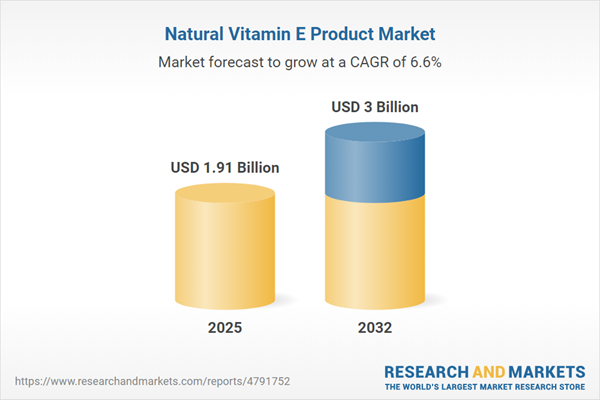Speak directly to the analyst to clarify any post sales queries you may have.
The natural Vitamin E market is undergoing rapid transformation as regulatory environments evolve, sustainability moves to the forefront, and buyer preferences demand adaptability. Leaders are rethinking operations and solutions to maintain advantage.
Market Snapshot: Global Natural Vitamin E Market Size and Growth
The global natural Vitamin E market is valued at USD 1.79 billion in 2024 and is expected to reach USD 1.91 billion by 2025, with long-term projections to USD 3.00 billion by 2032. This stable expansion is fueled by rising demand for clean-label ingredients and significant sustainability commitments throughout the value chain. Key industries bolstering market strength include functional foods, dietary supplements, and personal care. Within these sectors, organizations emphasize robust ingredient sourcing and innovation in product delivery to address compliance and market shifts. These evolving dynamics necessitate agile supply chains and continuous investment in competitive advancement.
Scope & Segmentation of the Natural Vitamin E Market
This report delivers detailed segmentation tailored to the strategic needs of senior executives pursuing market entry, portfolio growth, or refined sourcing strategies.
- Source: Fruits, vegetables, nuts, seeds, and grains serve as the foundation for ingredient sourcing, enabling alignment with a broad range of consumer values and advancing cross-functional sustainability targets.
- Product Form: Concentrates, powders, capsules, and tablets provide the flexibility to match evolving end-use requirements and differentiate in crowded markets.
- Distribution Channel: Traditional retail, digital platforms, and wholesale distribution enable tailored regional expansion and targeted customer engagement across global marketplaces.
- Application: Animal nutrition, dietary supplements, cosmetics, functional foods, beverages, and pharmaceuticals each present unique regulatory and formulation challenges, calling for market-specific planning and specialist partnerships.
- Regional Coverage: Analysis includes the Americas, Europe, Middle East and Africa, and Asia-Pacific, emphasizing the need to adapt to diverse regulatory climates, consumer trends, and localized partnership frameworks in key markets like the US, China, Germany, South Africa, and Brazil.
- Company Coverage: Leading enterprises such as BASF SE, Koninklijke DSM N.V., Archer-Daniels-Midland Company, and Kemin Industries are profiled, providing benchmarks and strategic insights based on their innovation and operational models.
Segmentation by these criteria empowers organizations to enhance supply stability, select appropriate technology solutions, and execute marketing strategies more effectively across a variety of sectors and territories.
Key Takeaways for Strategic Decision-Making
- Adoption of advanced extraction technologies—including supercritical CO₂ and enzymatic processes—is supporting compliance and sustainability objectives across diverse applications.
- Transparent supply chain initiatives strengthen business partnerships and enable swifter response to regulatory changes in core and emerging regions.
- Ethically sourced, clean-label product development is fostering deeper supplier collaboration and supporting the creation of robust procurement networks.
- Diversifying ingredient sources and finished product forms helps organizations adapt to dynamic procurement trends and sector shifts.
- Strategic collaboration between suppliers and manufacturers enhances agility, enabling rapid adaptation to market disruptions and the strengthening of value chains.
Tariff Impact: Strategic Response to Upcoming U.S. Trade Measures
Upcoming U.S. tariffs are poised to increase supply chain complexity and operational costs, contributing to market uncertainty. Leading companies are proactively collaborating with suppliers, restructuring workflows, and consulting regulatory specialists. These risk mitigation strategies are critical for maintaining continuity and flexibility in volatile trade environments.
Methodology & Data Sources
This assessment integrates primary research—executive interviews, regulator discussions, and technical expert insights—with secondary methods such as benchmarking, patent analysis, and regulatory review. This structure ensures actionable guidance for B2B professionals working to balance risk and capitalize on emerging opportunities in the natural Vitamin E sector.
Why This Report Matters for B2B Leaders in Natural Vitamin E
- Delivers actionable recommendations for navigating regulatory challenges and complex supply dynamics based on robust, data-driven analysis.
- Equips senior leaders with frameworks to strengthen sourcing strategies and increase risk management resilience in volatile international trade scenarios.
- Enhances long-term partnership development and drives operational innovation through clear, integrity-focused market intelligence.
Conclusion
Sustained growth in the natural Vitamin E market demands strategic innovation, ethical procurement, and agile leadership. Focusing on these pillars positions organizations to navigate industry shifts and secure long-term success.
Additional Product Information:
- Purchase of this report includes 1 year online access with quarterly updates.
- This report can be updated on request. Please contact our Customer Experience team using the Ask a Question widget on our website.
Table of Contents
3. Executive Summary
4. Market Overview
7. Cumulative Impact of Artificial Intelligence 2025
Companies Mentioned
The companies profiled in this Natural Vitamin E Product market report include:- BASF SE
- Koninklijke DSM N.V.
- Archer-Daniels-Midland Company
- Kemin Industries, Inc.
- Aceto Corporation
- Zhejiang Medicine Co., Ltd.
- Gnosis S.p.A.
- Genisco Technology Corporation
- Jiangsu Sucro Chemical Co., Ltd.
- Shaanxi Jintai Natural Product Co., Ltd.
Table Information
| Report Attribute | Details |
|---|---|
| No. of Pages | 183 |
| Published | November 2025 |
| Forecast Period | 2025 - 2032 |
| Estimated Market Value ( USD | $ 1.91 Billion |
| Forecasted Market Value ( USD | $ 3 Billion |
| Compound Annual Growth Rate | 6.6% |
| Regions Covered | Global |
| No. of Companies Mentioned | 11 |









